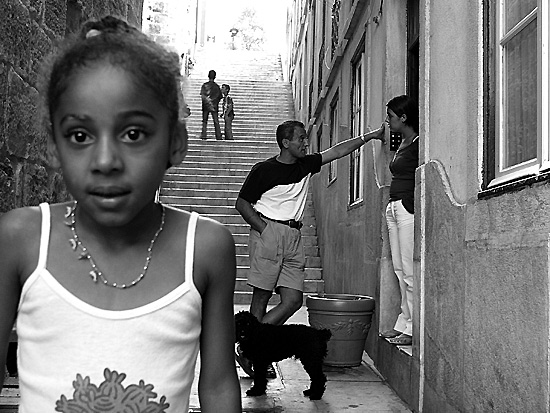Alfama é fácil de Amar
2002-2003
Os muçulmanos chamavam-lhe, no século VIII, Al-Alhaman (a fonte) devido aos seus chafarizes que abasteciam Lisboa de água potável. Alfama acabava no mar e numa enorme praia que rodeava Lisboa.
No século XIV e XV era um dos bairros onde viviam as minorias religiosas. Ali viviam os Judeus que trabalhavam nos estaleiros navais às portas de Alfama. Actualmente apenas o nome da Rua da Judiaria, uma sombria e melancólica ruela de Alfama, evoca a efémera existência desse bairro judeu.
Abriga os Estudos Gerais no século XV e XVI. Embora ainda restrito em finais do século XV, o número de estudantes justificava a criação deste embrião universitário, que permaneceu na Rua das Escolas Gerais até ser transferido definitivamente para Coimbra no ano de 1537.
Alfama é uma das zonas de Lisboa que sobreviveu ao Terramoto de 1755, e através dela podemos hoje imaginar como era a cidade nessa época.
No século XIX Alfama possui várias oficinas pequenas relegadas pelo "progresso" para fora da cidade. Neste bairro existem fábricas de curtumes, fábricas de biscoitos, oficinas, matadouros, olarias, recuperação de trapos e papéis usados, de velas e de cera.
Hoje é essencialente um bairro habitacional e histórico da cidade de Lisboa, onde não é difícil perder-se. São becos, ruas, ruelas e vielas que se articulam entre si ligados por lanços de escadas de calçada que vencem os desníveis da encosta.
E é neste sobe e desce que se vai avançado à descoberta de um mundo diferente das avenidas cosmopolitas, dos centros comerciais ou das lojas da moda. Caminhando pelas vielas, sente-se outra atmosfera, onde nem o bulício urbano nos perturba, como se este fosse um mundo à parte...um micro-cosmos dentro da europeia Lisboa.
Por entre estas ruas estreitas que exalam cheiros e sabores, tragédias e histórias de amores sente-se o fado. Desgarrado ou vadio, é fácil encontrar algum poiso apetecível por entre tascas ou restaurantes minúsculos que acolhem os apreciadores desta arte tão lusitana.
Esta é Alfama, um bairro a que podemos chamar labiríntico, confuso, aglomerado, policromo, tortuoso, contorcido, cheio de abraços de ruelas e de beijos, arcos, alfurjas, becos, escadarias e planos, serventias e pátios.
Essencialmente este é um bairro tradicional, daqueles em que os vizinhos se conhecem e falam de porta a porta ou de janela a janela...como na época dos muçulmanos ou dos judeus.
Texto Sofia Quintas
Fontes:
"História de Lisboa", Dejanirah Couto, Gótica 2000; Site Lifecooler.

